2006 MERCEDES-BENZ SPRINTER diagram
[x] Cancel search: diagramPage 2264 of 2305
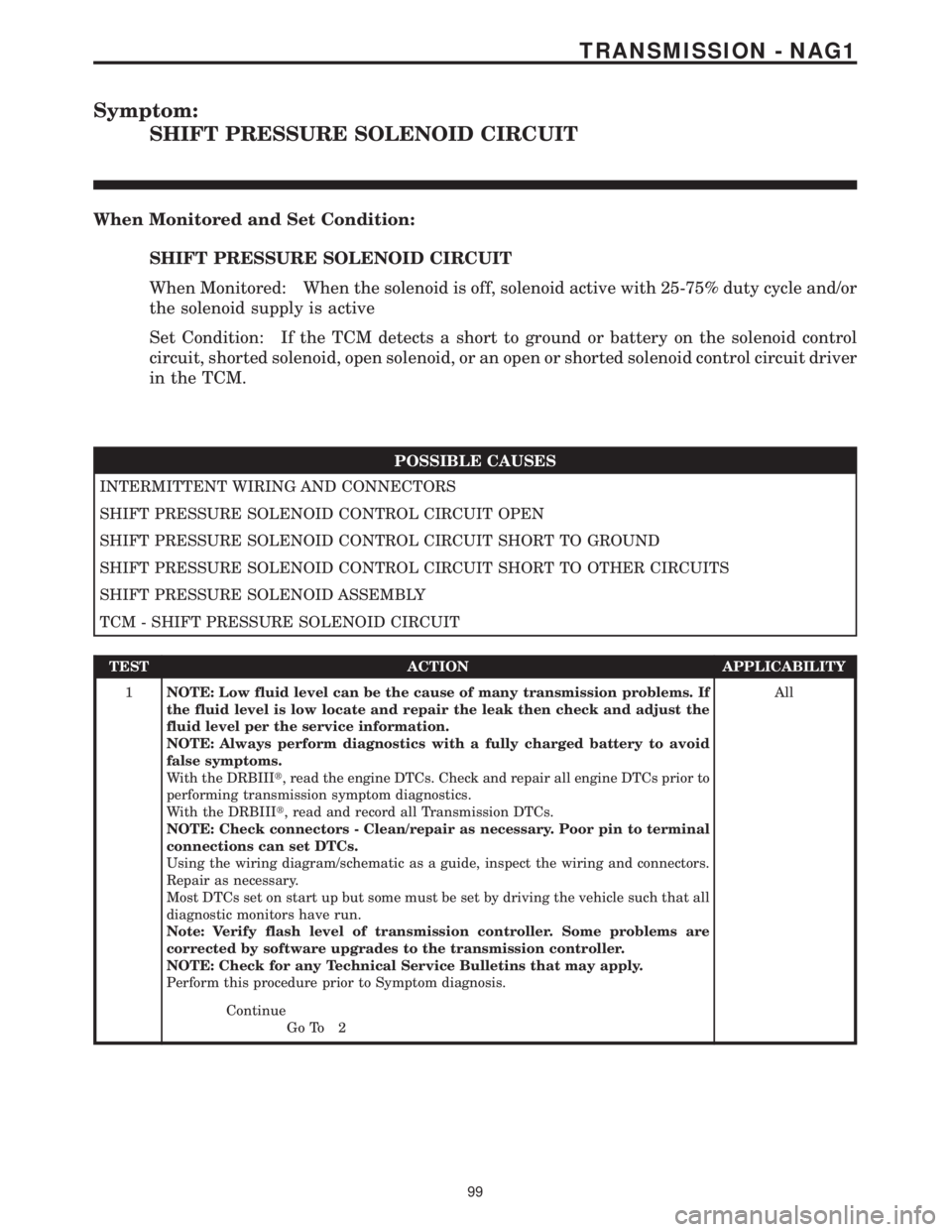
Symptom:
SHIFT PRESSURE SOLENOID CIRCUIT
When Monitored and Set Condition:
SHIFT PRESSURE SOLENOID CIRCUIT
When Monitored: When the solenoid is off, solenoid active with 25-75% duty cycle and/or
the solenoid supply is active
Set Condition: If the TCM detects a short to ground or battery on the solenoid control
circuit, shorted solenoid, open solenoid, or an open or shorted solenoid control circuit driver
in the TCM.
POSSIBLE CAUSES
INTERMITTENT WIRING AND CONNECTORS
SHIFT PRESSURE SOLENOID CONTROL CIRCUIT OPEN
SHIFT PRESSURE SOLENOID CONTROL CIRCUIT SHORT TO GROUND
SHIFT PRESSURE SOLENOID CONTROL CIRCUIT SHORT TO OTHER CIRCUITS
SHIFT PRESSURE SOLENOID ASSEMBLY
TCM - SHIFT PRESSURE SOLENOID CIRCUIT
TEST ACTION APPLICABILITY
1NOTE: Low fluid level can be the cause of many transmission problems. If
the fluid level is low locate and repair the leak then check and adjust the
fluid level per the service information.
NOTE: Always perform diagnostics with a fully charged battery to avoid
false symptoms.
With the DRBIIIt, read the engine DTCs. Check and repair all engine DTCs prior to
performing transmission symptom diagnostics.
With the DRBIIIt, read and record all Transmission DTCs.
NOTE: Check connectors - Clean/repair as necessary. Poor pin to terminal
connections can set DTCs.
Using the wiring diagram/schematic as a guide, inspect the wiring and connectors.
Repair as necessary.
Most DTCs set on start up but some must be set by driving the vehicle such that all
diagnostic monitors have run.
Note: Verify flash level of transmission controller. Some problems are
corrected by software upgrades to the transmission controller.
NOTE: Check for any Technical Service Bulletins that may apply.
Perform this procedure prior to Symptom diagnosis.All
Continue
Go To 2
99
TRANSMISSION - NAG1
Page 2267 of 2305
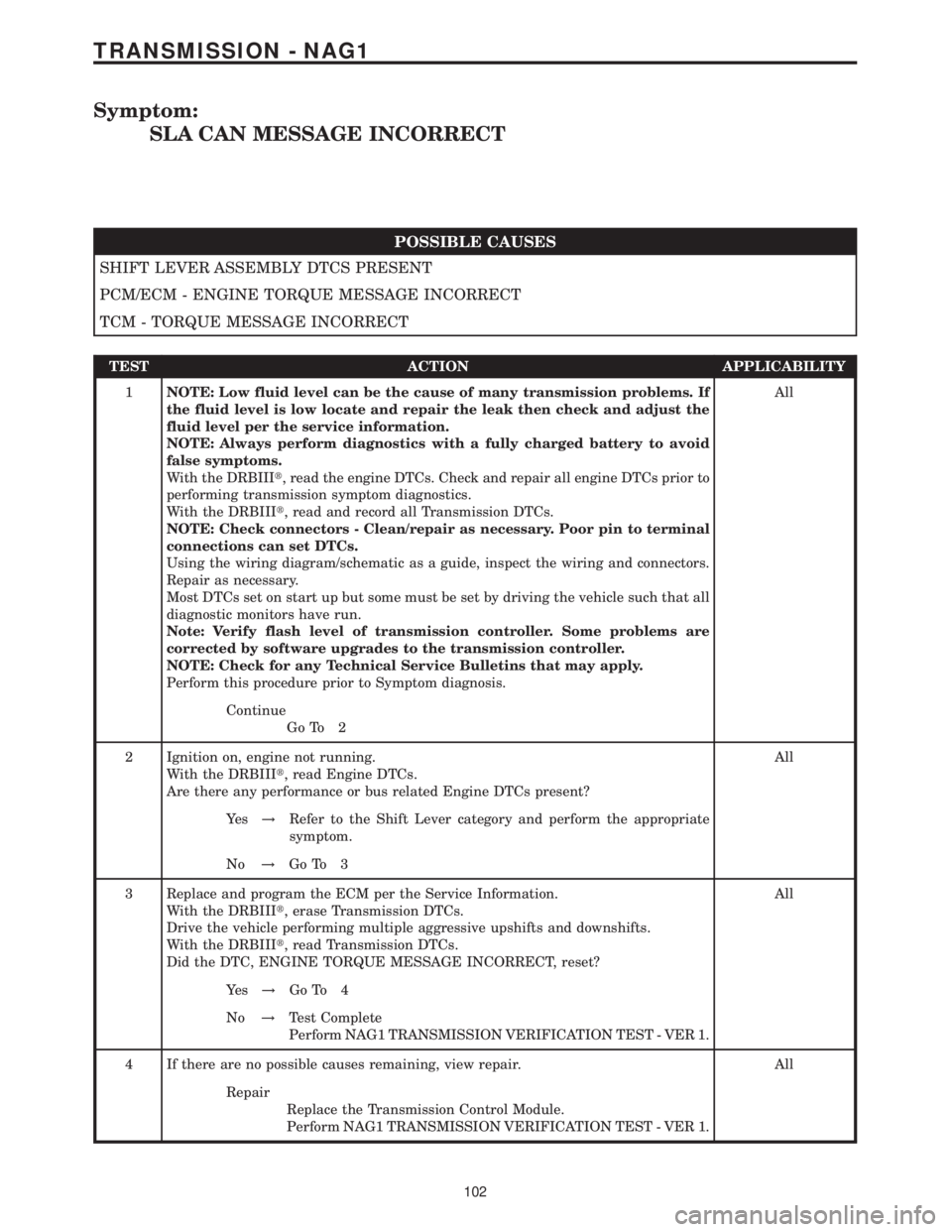
Symptom:
SLA CAN MESSAGE INCORRECT
POSSIBLE CAUSES
SHIFT LEVER ASSEMBLY DTCS PRESENT
PCM/ECM - ENGINE TORQUE MESSAGE INCORRECT
TCM - TORQUE MESSAGE INCORRECT
TEST ACTION APPLICABILITY
1NOTE: Low fluid level can be the cause of many transmission problems. If
the fluid level is low locate and repair the leak then check and adjust the
fluid level per the service information.
NOTE: Always perform diagnostics with a fully charged battery to avoid
false symptoms.
With the DRBIIIt, read the engine DTCs. Check and repair all engine DTCs prior to
performing transmission symptom diagnostics.
With the DRBIIIt, read and record all Transmission DTCs.
NOTE: Check connectors - Clean/repair as necessary. Poor pin to terminal
connections can set DTCs.
Using the wiring diagram/schematic as a guide, inspect the wiring and connectors.
Repair as necessary.
Most DTCs set on start up but some must be set by driving the vehicle such that all
diagnostic monitors have run.
Note: Verify flash level of transmission controller. Some problems are
corrected by software upgrades to the transmission controller.
NOTE: Check for any Technical Service Bulletins that may apply.
Perform this procedure prior to Symptom diagnosis.All
Continue
Go To 2
2 Ignition on, engine not running.
With the DRBIIIt, read Engine DTCs.
Are there any performance or bus related Engine DTCs present?All
Ye s!Refer to the Shift Lever category and perform the appropriate
symptom.
No!Go To 3
3 Replace and program the ECM per the Service Information.
With the DRBIIIt, erase Transmission DTCs.
Drive the vehicle performing multiple aggressive upshifts and downshifts.
With the DRBIIIt, read Transmission DTCs.
Did the DTC, ENGINE TORQUE MESSAGE INCORRECT, reset?All
Ye s!Go To 4
No!Test Complete
Perform NAG1 TRANSMISSION VERIFICATION TEST - VER 1.
4 If there are no possible causes remaining, view repair. All
Repair
Replace the Transmission Control Module.
Perform NAG1 TRANSMISSION VERIFICATION TEST - VER 1.
102
TRANSMISSION - NAG1
Page 2268 of 2305
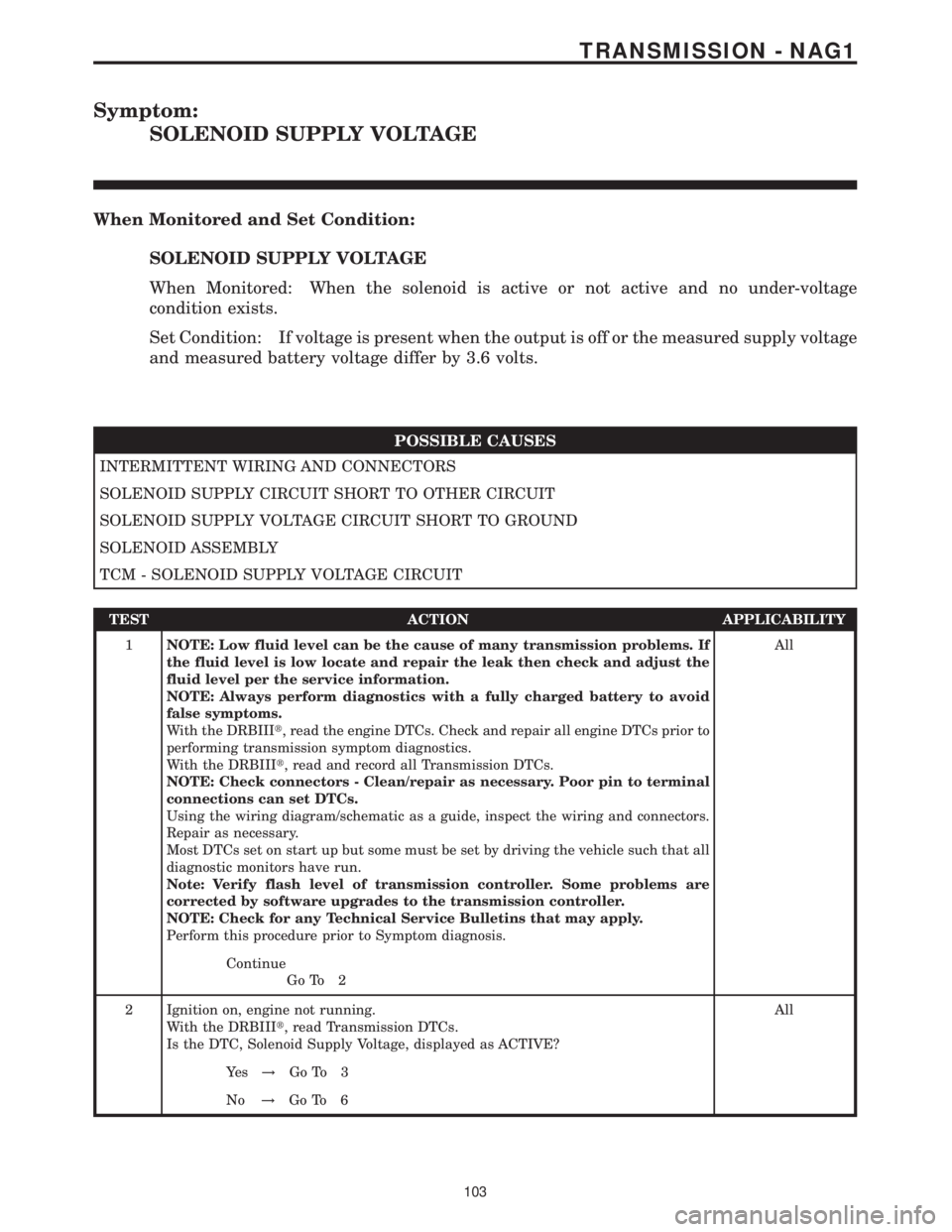
Symptom:
SOLENOID SUPPLY VOLTAGE
When Monitored and Set Condition:
SOLENOID SUPPLY VOLTAGE
When Monitored: When the solenoid is active or not active and no under-voltage
condition exists.
Set Condition: If voltage is present when the output is off or the measured supply voltage
and measured battery voltage differ by 3.6 volts.
POSSIBLE CAUSES
INTERMITTENT WIRING AND CONNECTORS
SOLENOID SUPPLY CIRCUIT SHORT TO OTHER CIRCUIT
SOLENOID SUPPLY VOLTAGE CIRCUIT SHORT TO GROUND
SOLENOID ASSEMBLY
TCM - SOLENOID SUPPLY VOLTAGE CIRCUIT
TEST ACTION APPLICABILITY
1NOTE: Low fluid level can be the cause of many transmission problems. If
the fluid level is low locate and repair the leak then check and adjust the
fluid level per the service information.
NOTE: Always perform diagnostics with a fully charged battery to avoid
false symptoms.
With the DRBIIIt, read the engine DTCs. Check and repair all engine DTCs prior to
performing transmission symptom diagnostics.
With the DRBIIIt, read and record all Transmission DTCs.
NOTE: Check connectors - Clean/repair as necessary. Poor pin to terminal
connections can set DTCs.
Using the wiring diagram/schematic as a guide, inspect the wiring and connectors.
Repair as necessary.
Most DTCs set on start up but some must be set by driving the vehicle such that all
diagnostic monitors have run.
Note: Verify flash level of transmission controller. Some problems are
corrected by software upgrades to the transmission controller.
NOTE: Check for any Technical Service Bulletins that may apply.
Perform this procedure prior to Symptom diagnosis.All
Continue
Go To 2
2 Ignition on, engine not running.
With the DRBIIIt, read Transmission DTCs.
Is the DTC, Solenoid Supply Voltage, displayed as ACTIVE?All
Ye s!Go To 3
No!Go To 6
103
TRANSMISSION - NAG1
Page 2270 of 2305
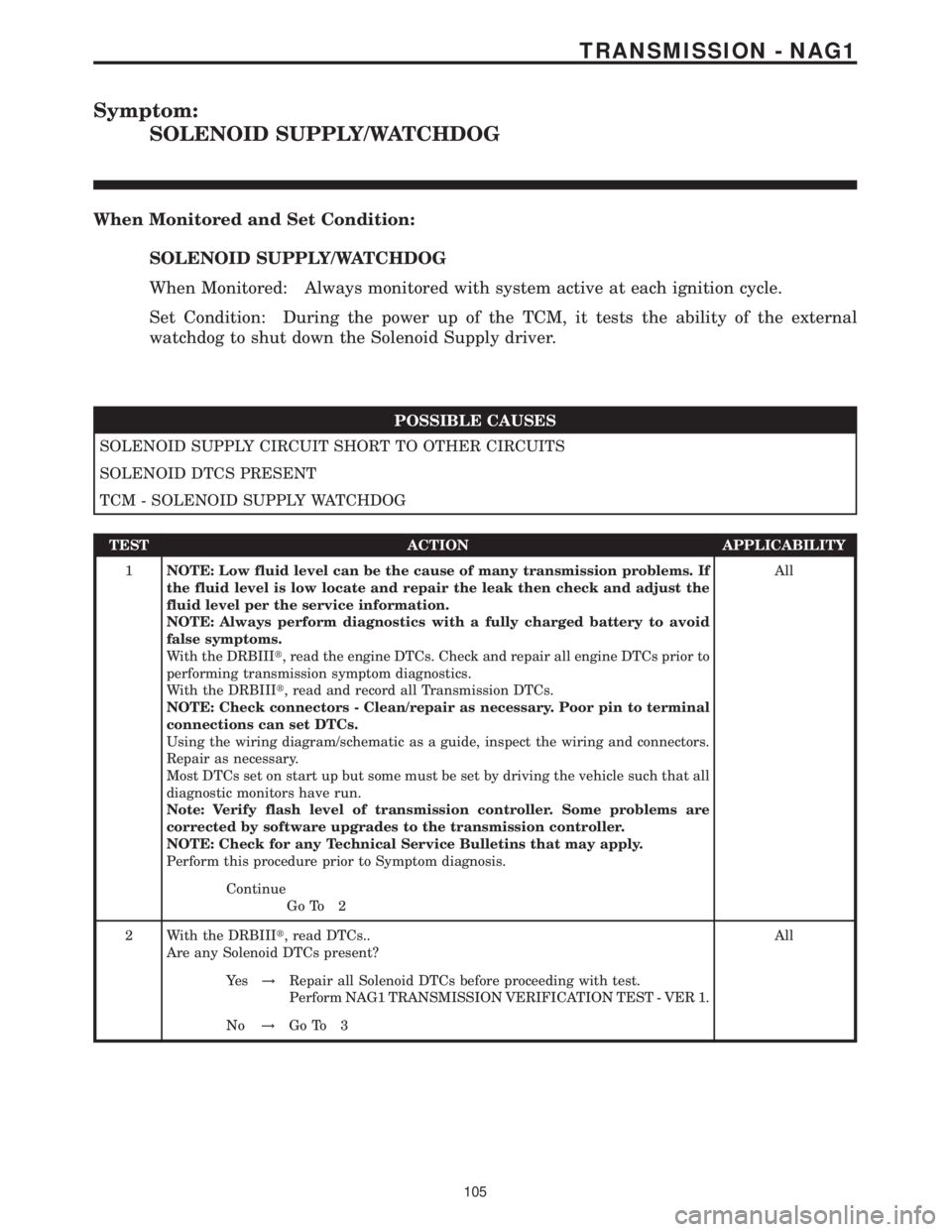
Symptom:
SOLENOID SUPPLY/WATCHDOG
When Monitored and Set Condition:
SOLENOID SUPPLY/WATCHDOG
When Monitored: Always monitored with system active at each ignition cycle.
Set Condition: During the power up of the TCM, it tests the ability of the external
watchdog to shut down the Solenoid Supply driver.
POSSIBLE CAUSES
SOLENOID SUPPLY CIRCUIT SHORT TO OTHER CIRCUITS
SOLENOID DTCS PRESENT
TCM - SOLENOID SUPPLY WATCHDOG
TEST ACTION APPLICABILITY
1NOTE: Low fluid level can be the cause of many transmission problems. If
the fluid level is low locate and repair the leak then check and adjust the
fluid level per the service information.
NOTE: Always perform diagnostics with a fully charged battery to avoid
false symptoms.
With the DRBIIIt, read the engine DTCs. Check and repair all engine DTCs prior to
performing transmission symptom diagnostics.
With the DRBIIIt, read and record all Transmission DTCs.
NOTE: Check connectors - Clean/repair as necessary. Poor pin to terminal
connections can set DTCs.
Using the wiring diagram/schematic as a guide, inspect the wiring and connectors.
Repair as necessary.
Most DTCs set on start up but some must be set by driving the vehicle such that all
diagnostic monitors have run.
Note: Verify flash level of transmission controller. Some problems are
corrected by software upgrades to the transmission controller.
NOTE: Check for any Technical Service Bulletins that may apply.
Perform this procedure prior to Symptom diagnosis.All
Continue
Go To 2
2 With the DRBIIIt, read DTCs..
Are any Solenoid DTCs present?All
Ye s!Repair all Solenoid DTCs before proceeding with test.
Perform NAG1 TRANSMISSION VERIFICATION TEST - VER 1.
No!Go To 3
105
TRANSMISSION - NAG1
Page 2272 of 2305
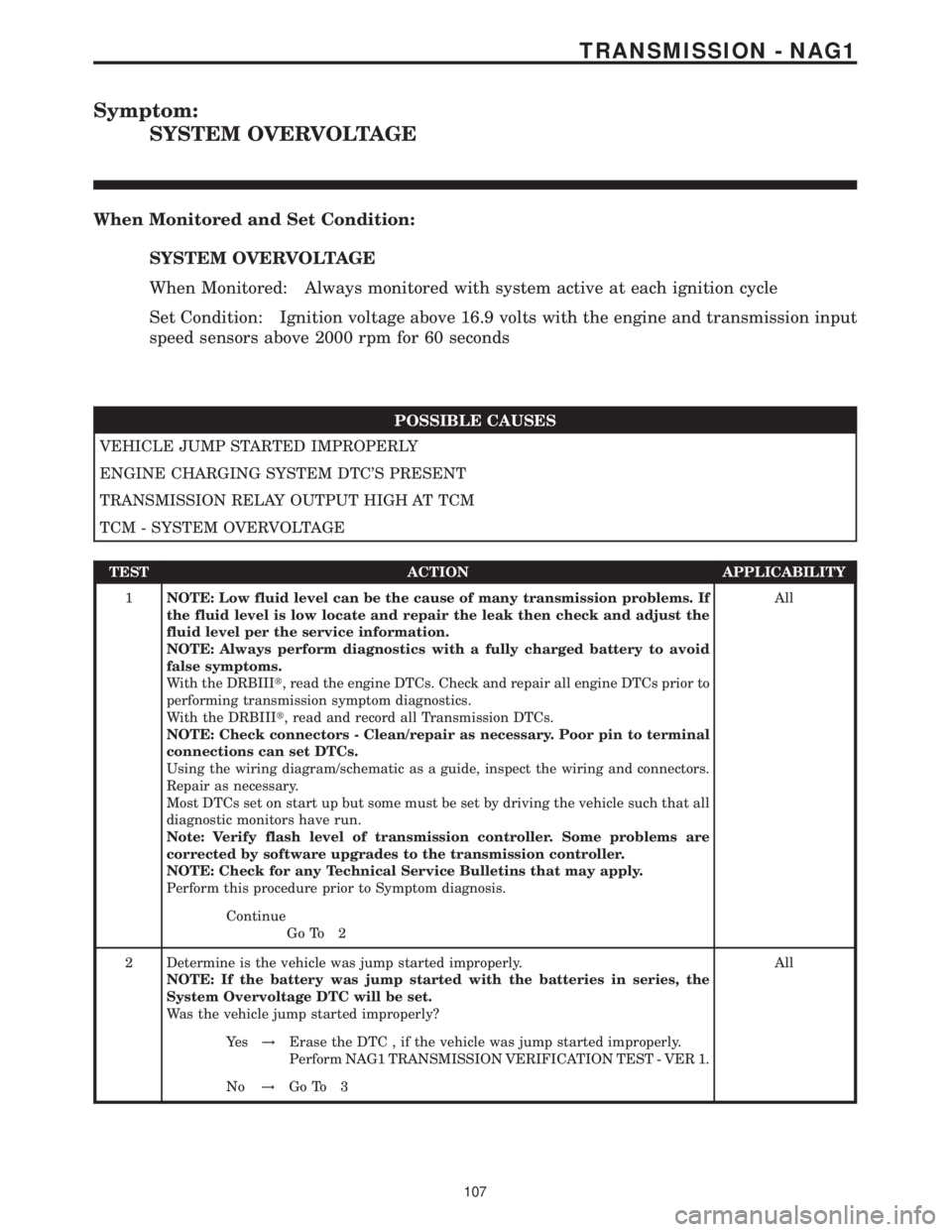
Symptom:
SYSTEM OVERVOLTAGE
When Monitored and Set Condition:
SYSTEM OVERVOLTAGE
When Monitored: Always monitored with system active at each ignition cycle
Set Condition: Ignition voltage above 16.9 volts with the engine and transmission input
speed sensors above 2000 rpm for 60 seconds
POSSIBLE CAUSES
VEHICLE JUMP STARTED IMPROPERLY
ENGINE CHARGING SYSTEM DTC'S PRESENT
TRANSMISSION RELAY OUTPUT HIGH AT TCM
TCM - SYSTEM OVERVOLTAGE
TEST ACTION APPLICABILITY
1NOTE: Low fluid level can be the cause of many transmission problems. If
the fluid level is low locate and repair the leak then check and adjust the
fluid level per the service information.
NOTE: Always perform diagnostics with a fully charged battery to avoid
false symptoms.
With the DRBIIIt, read the engine DTCs. Check and repair all engine DTCs prior to
performing transmission symptom diagnostics.
With the DRBIIIt, read and record all Transmission DTCs.
NOTE: Check connectors - Clean/repair as necessary. Poor pin to terminal
connections can set DTCs.
Using the wiring diagram/schematic as a guide, inspect the wiring and connectors.
Repair as necessary.
Most DTCs set on start up but some must be set by driving the vehicle such that all
diagnostic monitors have run.
Note: Verify flash level of transmission controller. Some problems are
corrected by software upgrades to the transmission controller.
NOTE: Check for any Technical Service Bulletins that may apply.
Perform this procedure prior to Symptom diagnosis.All
Continue
Go To 2
2 Determine is the vehicle was jump started improperly.
NOTE: If the battery was jump started with the batteries in series, the
System Overvoltage DTC will be set.
Was the vehicle jump started improperly?All
Ye s!Erase the DTC , if the vehicle was jump started improperly.
Perform NAG1 TRANSMISSION VERIFICATION TEST - VER 1.
No!Go To 3
107
TRANSMISSION - NAG1
Page 2274 of 2305
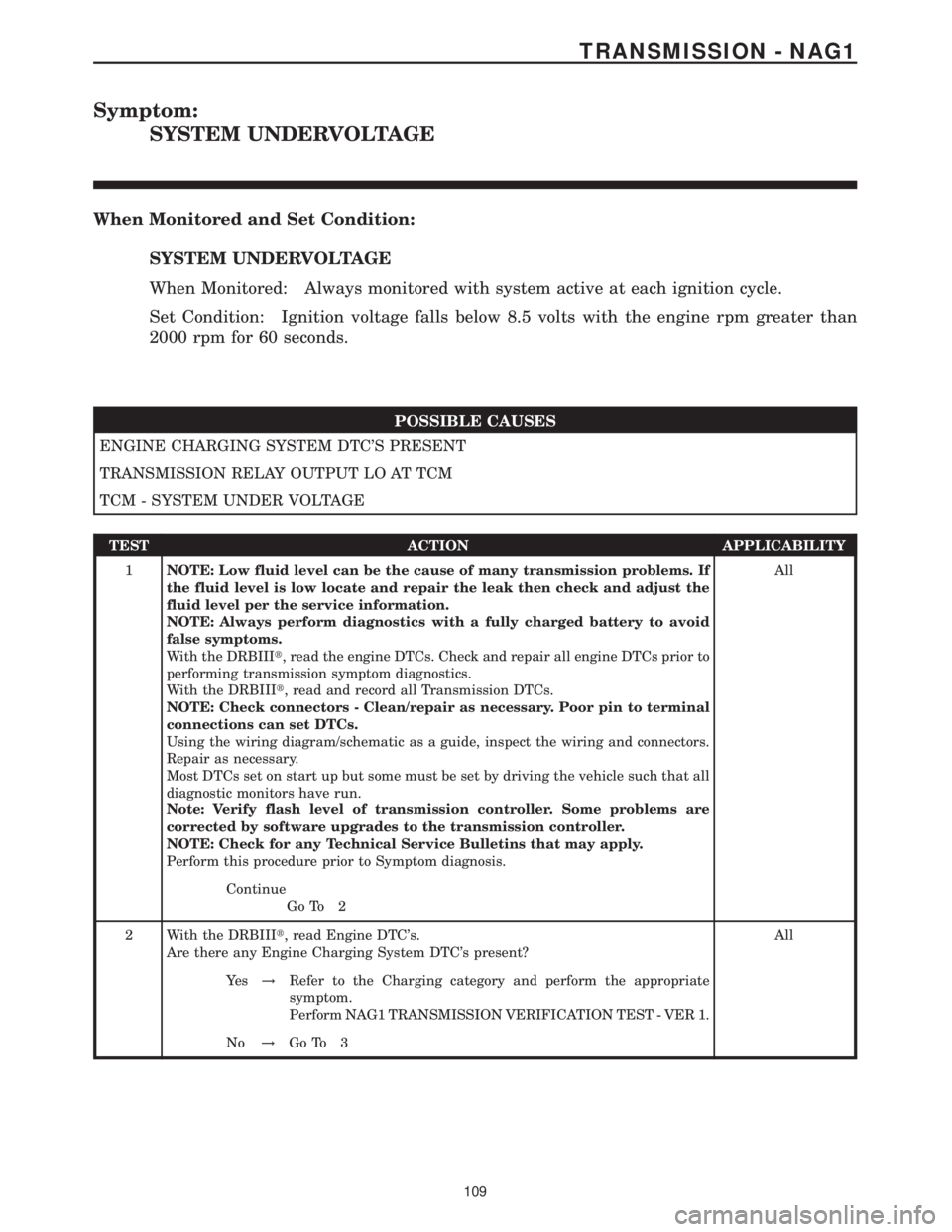
Symptom:
SYSTEM UNDERVOLTAGE
When Monitored and Set Condition:
SYSTEM UNDERVOLTAGE
When Monitored: Always monitored with system active at each ignition cycle.
Set Condition: Ignition voltage falls below 8.5 volts with the engine rpm greater than
2000 rpm for 60 seconds.
POSSIBLE CAUSES
ENGINE CHARGING SYSTEM DTC'S PRESENT
TRANSMISSION RELAY OUTPUT LO AT TCM
TCM - SYSTEM UNDER VOLTAGE
TEST ACTION APPLICABILITY
1NOTE: Low fluid level can be the cause of many transmission problems. If
the fluid level is low locate and repair the leak then check and adjust the
fluid level per the service information.
NOTE: Always perform diagnostics with a fully charged battery to avoid
false symptoms.
With the DRBIIIt, read the engine DTCs. Check and repair all engine DTCs prior to
performing transmission symptom diagnostics.
With the DRBIIIt, read and record all Transmission DTCs.
NOTE: Check connectors - Clean/repair as necessary. Poor pin to terminal
connections can set DTCs.
Using the wiring diagram/schematic as a guide, inspect the wiring and connectors.
Repair as necessary.
Most DTCs set on start up but some must be set by driving the vehicle such that all
diagnostic monitors have run.
Note: Verify flash level of transmission controller. Some problems are
corrected by software upgrades to the transmission controller.
NOTE: Check for any Technical Service Bulletins that may apply.
Perform this procedure prior to Symptom diagnosis.All
Continue
Go To 2
2 With the DRBIIIt, read Engine DTC's.
Are there any Engine Charging System DTC's present?All
Ye s!Refer to the Charging category and perform the appropriate
symptom.
Perform NAG1 TRANSMISSION VERIFICATION TEST - VER 1.
No!Go To 3
109
TRANSMISSION - NAG1
Page 2276 of 2305
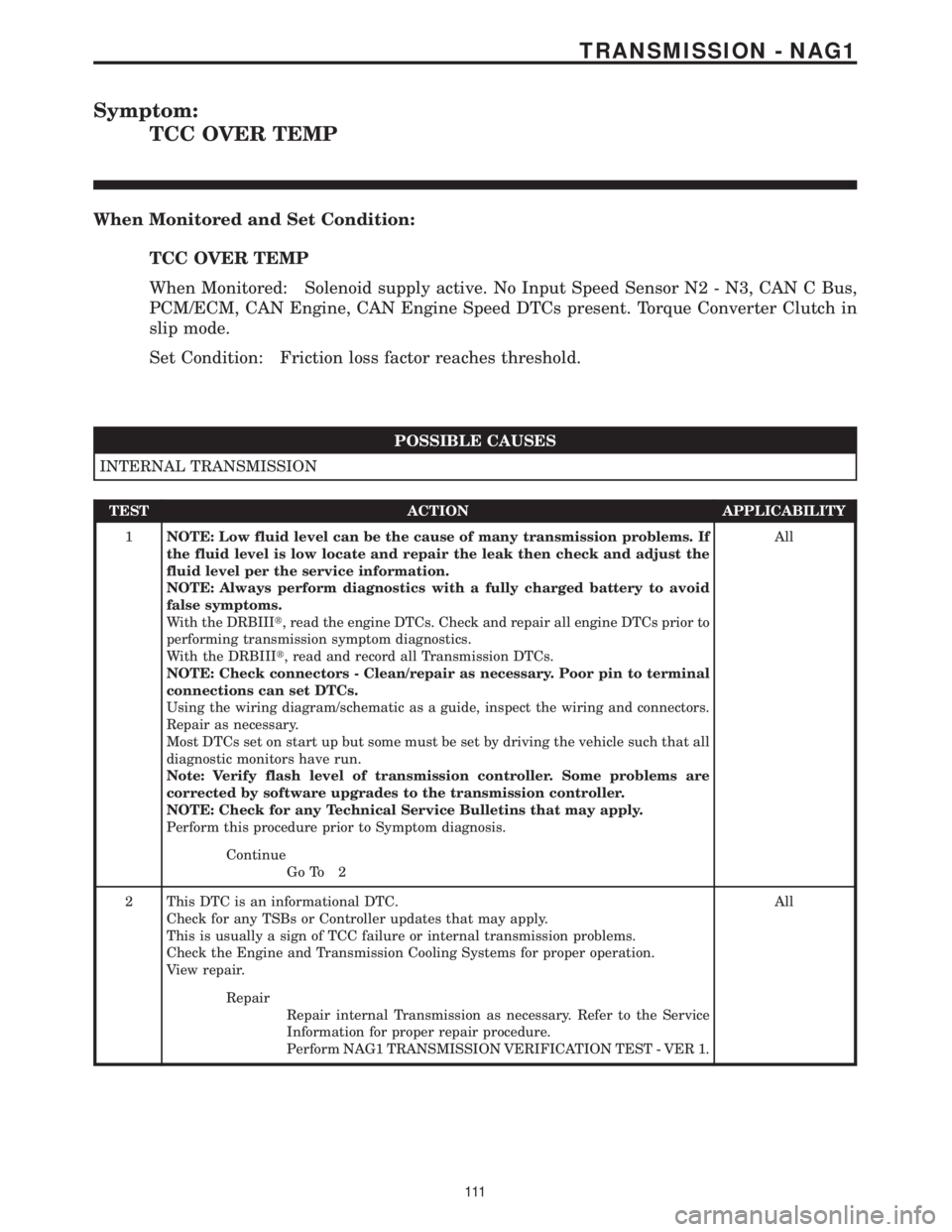
Symptom:
TCC OVER TEMP
When Monitored and Set Condition:
TCC OVER TEMP
When Monitored: Solenoid supply active. No Input Speed Sensor N2 - N3, CAN C Bus,
PCM/ECM, CAN Engine, CAN Engine Speed DTCs present. Torque Converter Clutch in
slip mode.
Set Condition: Friction loss factor reaches threshold.
POSSIBLE CAUSES
INTERNAL TRANSMISSION
TEST ACTION APPLICABILITY
1NOTE: Low fluid level can be the cause of many transmission problems. If
the fluid level is low locate and repair the leak then check and adjust the
fluid level per the service information.
NOTE: Always perform diagnostics with a fully charged battery to avoid
false symptoms.
With the DRBIIIt, read the engine DTCs. Check and repair all engine DTCs prior to
performing transmission symptom diagnostics.
With the DRBIIIt, read and record all Transmission DTCs.
NOTE: Check connectors - Clean/repair as necessary. Poor pin to terminal
connections can set DTCs.
Using the wiring diagram/schematic as a guide, inspect the wiring and connectors.
Repair as necessary.
Most DTCs set on start up but some must be set by driving the vehicle such that all
diagnostic monitors have run.
Note: Verify flash level of transmission controller. Some problems are
corrected by software upgrades to the transmission controller.
NOTE: Check for any Technical Service Bulletins that may apply.
Perform this procedure prior to Symptom diagnosis.All
Continue
Go To 2
2 This DTC is an informational DTC.
Check for any TSBs or Controller updates that may apply.
This is usually a sign of TCC failure or internal transmission problems.
Check the Engine and Transmission Cooling Systems for proper operation.
View repair.All
Repair
Repair internal Transmission as necessary. Refer to the Service
Information for proper repair procedure.
Perform NAG1 TRANSMISSION VERIFICATION TEST - VER 1.
111
TRANSMISSION - NAG1
Page 2277 of 2305
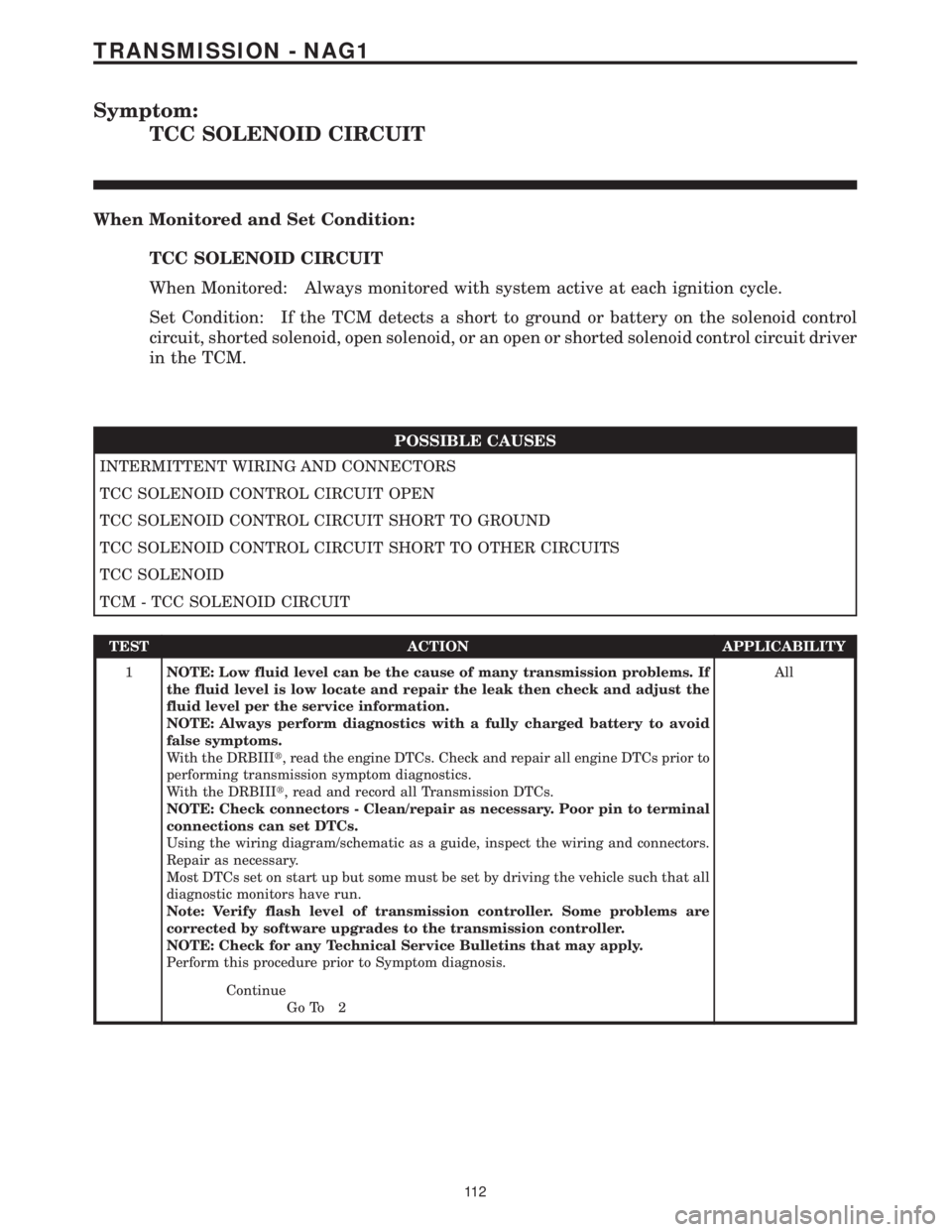
Symptom:
TCC SOLENOID CIRCUIT
When Monitored and Set Condition:
TCC SOLENOID CIRCUIT
When Monitored: Always monitored with system active at each ignition cycle.
Set Condition: If the TCM detects a short to ground or battery on the solenoid control
circuit, shorted solenoid, open solenoid, or an open or shorted solenoid control circuit driver
in the TCM.
POSSIBLE CAUSES
INTERMITTENT WIRING AND CONNECTORS
TCC SOLENOID CONTROL CIRCUIT OPEN
TCC SOLENOID CONTROL CIRCUIT SHORT TO GROUND
TCC SOLENOID CONTROL CIRCUIT SHORT TO OTHER CIRCUITS
TCC SOLENOID
TCM - TCC SOLENOID CIRCUIT
TEST ACTION APPLICABILITY
1NOTE: Low fluid level can be the cause of many transmission problems. If
the fluid level is low locate and repair the leak then check and adjust the
fluid level per the service information.
NOTE: Always perform diagnostics with a fully charged battery to avoid
false symptoms.
With the DRBIIIt, read the engine DTCs. Check and repair all engine DTCs prior to
performing transmission symptom diagnostics.
With the DRBIIIt, read and record all Transmission DTCs.
NOTE: Check connectors - Clean/repair as necessary. Poor pin to terminal
connections can set DTCs.
Using the wiring diagram/schematic as a guide, inspect the wiring and connectors.
Repair as necessary.
Most DTCs set on start up but some must be set by driving the vehicle such that all
diagnostic monitors have run.
Note: Verify flash level of transmission controller. Some problems are
corrected by software upgrades to the transmission controller.
NOTE: Check for any Technical Service Bulletins that may apply.
Perform this procedure prior to Symptom diagnosis.All
Continue
Go To 2
11 2
TRANSMISSION - NAG1